What is SHFT
SHFT IS YOUR PERSONAL VIRTUAL RUNNING COACH
SHFT is a virtual running coach that will help you become a better and faster runner step by step. SHFT gives you instructions as you run to hep you improve your technique, avoid injuries and become a better, faster and happier runner. SHFT will help you unlock your running potential.

REAL-TIME
COACHING

FULL BODY
METRICS

INJURY
PREVENTION

COACH
REPORTS

COMPLETE
RUN STATS

TRAINING
DRILLS
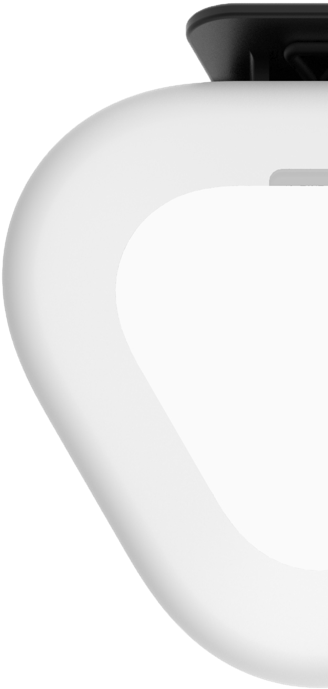
12 RUNNING METRICS
SHFT running metrics enable the coach to analyze and track your development, to ensure you are within your target zone and thereby on the path to reaching a more efficient running style. SHFT focuses on one metric during each technical run and give you real-time coaching based on your performanceacross the different running metrics

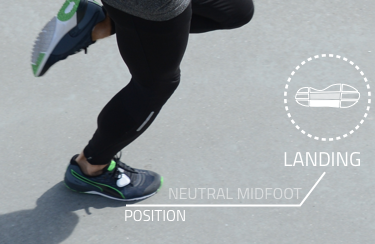

What is landing position?
Landing Position is a measure of your foot’s position at initial ground contact. Roughly, Landing Position is divided into three styles: heel landing, forefoot landing, and midfoot landing. Depending on your Landing Position, you either increase or decrease the impact on your body, and affect your Running Efficiency in a positive or negative way.
Why is it important?
When you run with your SHFT coach on, you will get information about your Landing Position and instructions on how to change your Landing Position from heel- or forefoot landing to midfoot. If you land on your heel, your SHFT coach will for example ask you to shorten your stride. If you run with your coach off, you will get the information about your Landing Position, but no instructions on how to improve. This is illustrated in your SHFT app and on the SHFT portal.

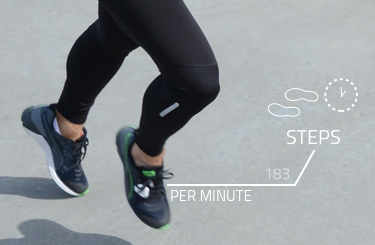

What is steps per minute?
In all its simplicity, Steps per Minute describe how many steps you take per minute. If your step rate is too low, your steps are probably too long, which may affect your Landing Position negatively. As a result, you increase the stress on your body, and decrease your Running Efficiency. Taking fewer steps per minute will probably affect your Landing Position positively, which might even raise your Running Efficiency.
Why is it important?
For your SHFT coach, Steps per Minute is an important metric, and your SHFT coach will always start by checking your status of this metric. If your coach thinks that your Steps per Minutes are too low, this is the metric that you will get coached on initially. To increase your Steps per Minute your SHFT coach will ask you to ”take more steps but keep the pace” or ”shorten your step”. Your speed is a combination of Steps per Minute and Step Length. You will speed up by either taking more or longer steps – or both.

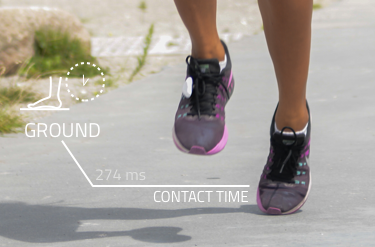

What is ground contact time?
The Ground Contact Time is the time your foot remains on the ground during your stride. A lower Ground Contact Time makes you run more efficient, while a higher Ground Contact Time leads to a lower efficiency.
Why is it important?
As long as you stay on the ground you will not move. The point where you move is when you are in the air. So your SHFT coach will help you get off the ground faster and make the transition into the next step smoother and faster. If you need to decrease your time on the ground your SHFT coach will tell you to ”lift your heel up under your hip faster” or ”stiffen up your body just slightly” to be a little springier. Getting off the ground faster is about using stored energy in your muscles and tendons efficiently.

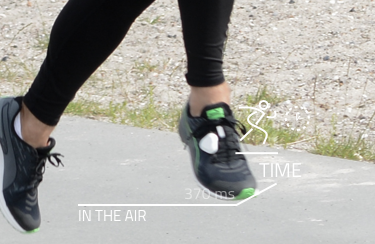

What is time in air?
Time in Air is the time your foot spends above the ground. The Time in Air is highly connected to your Ground Contact Time, Steps per Minute, and your running pace.
Why is it important?
One important difference between walking and running is that when we walk, Time in Air equals the time on the ground. When we run we want the Time in Air to be long and the Ground Contact Time to be short.

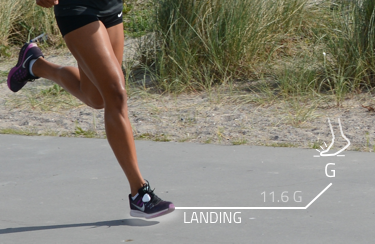

What is g-landing?
The G-Landing is the force of the impact at your initial contact with the ground. Running pace, Landing Position, and almost everything you are doing right before you land on the ground, will influence your G-Landing. The G-Landing even gives some information about the surface the runner is running on. The harder the surface is the higher the G will be, and the softer the surface the lower the G.
Why is it important?
When you speed up, your G-Landing will always increase, but the distribution of impact will be different depending on your landing position. G-Landing can never be zero due to the weight of your body, but Landing position, Landing angle and Body Bounce will make your G-Landing increase or decrease. When you speed up, your G-Landing will always increase, but the distribution of impact will differ depending on your Landing Position.

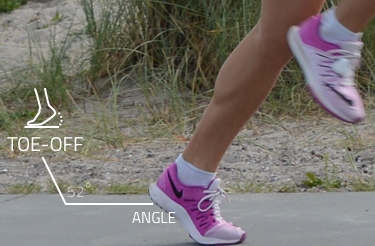

What is toe-off angle?
The Toe-off Angle is the angle between your foot and the ground, right before you leave the ground.
Why is it important?
The Toe-off Angle helps the coach to get more information about other metrics, among other the Ground Contact Time. If the data shows a low Toe-off Angle the coach can assume that the runner leaves the ground a little too early and cannot run with a powerful stride. Furthermore, we are doing some research about how to use the Toe-Off-Angle to predict hip extension, which is one of the key elements of an efficient running technique.
Caution: We assume the pace is even!

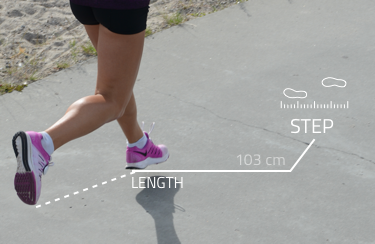

What is step length?
The Step Length in combination with your Steps per Minute defines your running pace. Longer steps will often result in a heel-oriented Landing Position, while shorter steps will result in a mid-foot-/forefoot-oriented Landing Position.
Why is it important?
The coach uses the Step Length to get more information about other metrics like Landing Position, where long steps often result in a heel-strike. If the steps are too long, the coach will instruct the runner to take shorter steps to improve his or her running technique. Example: Taking long steps would mean having a low step frequency and/or a high Ground Contact Time and/or a heel-strike.
Caution: We assume the pace is even!

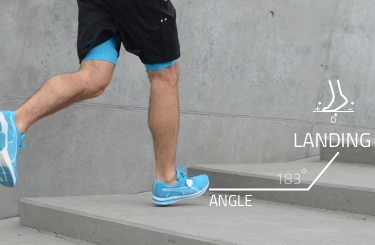

What is landing angle?
The Landing Angle describes the angle between your foot and the ground at initial contact. The Landing Angle has a high correlation with your Landing Position. The Landing Angle is the angle between your foot and the ground the moment you touch it. A negative angle indicates a heel landing, while a positive angle indicates a forefoot landing. If the angle is 0, it is a midfoot landing.
Why is it important?
The coach uses the Landing Angle to have a closer look at the way you land on the ground. The higher or lower the angle is, the more extreme you are landing on your heel or your forefoot. See the Landing Angle as an even more precise definition of the Landing Position.



What is power?
SHFT works with Power, a new metric changing the running industry's look on how to run more efficiently. We have consciously decided not to use heart rate (HR) measurements, as it is not precise enough in reflecting a runners current output. Your heart rate is dependent on a lot of different factors: stress, coffee-intake and age are just a few of the factors that will influence your HR. At SHFT, we find Watt to be the most accurate method to measure your running. Watt is the sum of the power you send on moving forward, braking, bouncing and the power used in lateral movements.
Why is it important?
Power can be used as a tool to plan the intensity of your training. The vision is to display the intensity of your running session with help of Power. Running with a certain amount of Power will make you target certain energy systems and improve the responsible metabolic processes. The idea is similar to the idea of using heart rate. We just consider Power as more reactive to changes in the training and because of that more reliable regarding the actual intensity.

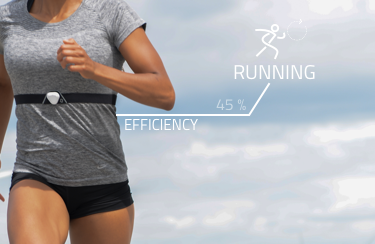

What is running efficiency?
The Running Efficiency is defined as being the power you use to move yourself forward compared to your overall power use (Watt). Running Efficiency is therefore measured in % and simply shows how efficient you are running.
Why is it important?
The coach uses the Running Efficiency as a tool to see how you are improving your running technique. Additionally, it gives the runner an idea of how his/her development is going.

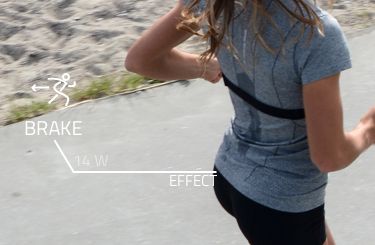

What is brake effect?
Brake Effect means the deceleration of your running movement. We measure the force, which is going backward instead of forward. The unit is G.
Why is it important?
Braking your forward movement means at the same time that you need to accelerate again to keep your pace. Even talking about milliseconds this is important regarding your running efficiency. On the other side a certain amount of braking is necessary to fully use the muscle-shortening-cycle.

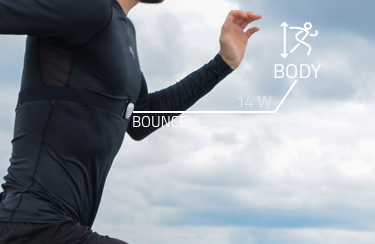

What is body bounce?
Body Bounce is the vertical movement – the “bounce” i.e. the up and down movement of your center of gravity during your running.
Why is it important?
If your Body Bounce is too high, your center of gravity essentially travels a longer vertical distance with every step you take during your run. As a result, you increase stress on your body.
 LANDING POSITION
LANDING POSITION
 STEPS PER MINUTE
STEPS PER MINUTE
 GROUND CONTACT TIME
GROUND CONTACT TIME
 TIME IN AIR
TIME IN AIR
 G-LANDING
G-LANDING
 TOE-OFF ANGLE
TOE-OFF ANGLE
 STEP LENGTH
STEP LENGTH
 LANDING ANGLE
LANDING ANGLE
 POWER
POWER
 RUNNING EFFICIENCY
RUNNING EFFICIENCY
 BRAKE EFFECT
BRAKE EFFECT
 BODY BOUNCE
BODY BOUNCE
THE SHFT PODS
- Connected via bluebooth.
- 100% puddle proof.
- Lightweight and easy to attached.
- Data triangulation.
- Award winning design.
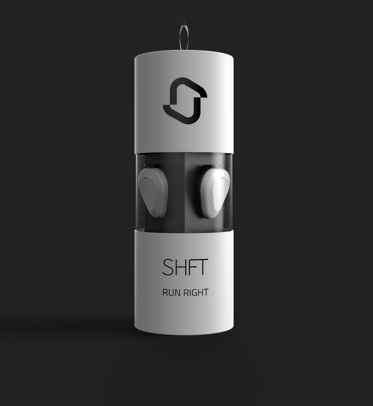
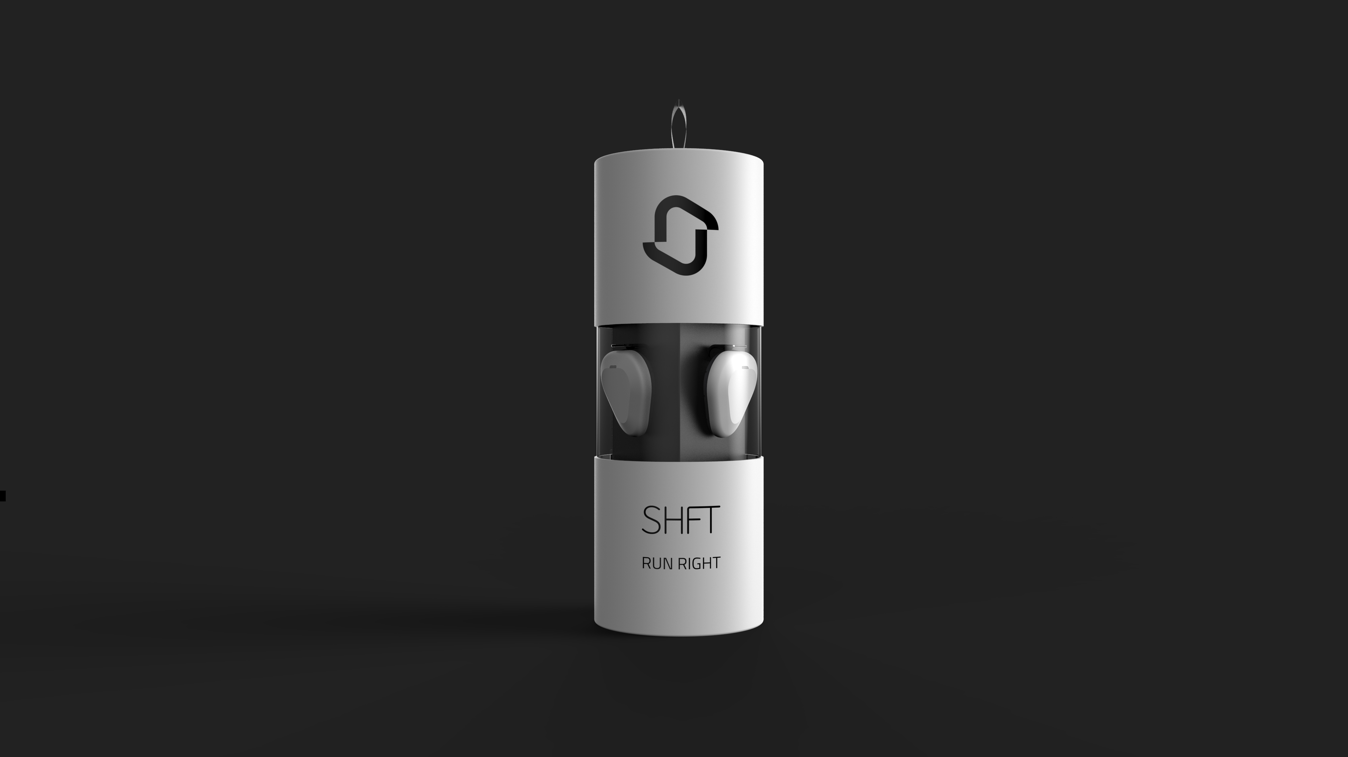 New Version 2.0
New Version 2.0
THE SHFT APP
- Available for both Android and IOS.
- Personalized profile.
- Overview of metrics and previous runs.
- Technical drill videos.
- Real-time feedback.
Download your shft app here
THE COACHING
You decide if you want to run with the SHFT coach on or off - SHFT will measure you either way, but only give you feedback if the coach is on. SHFT coaches you based on intelligent measures and aimes to make you a better runner by providing real-time feedback and telling you if you are out of your target zone. After each run you will get a coach report including medical advise informing you on the relevance of the metric.
SHFT RUN = 31 MINUTES IN TOTAL








